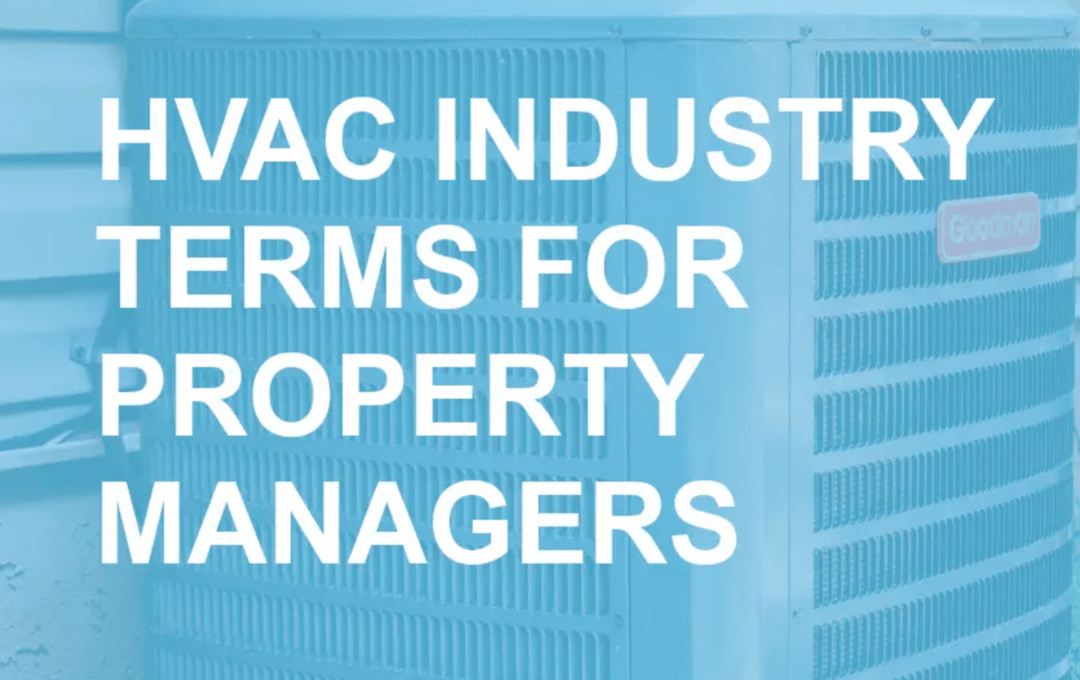HVAC (heating, ventilation, and air conditioning) is a significant sub-discipline of mechanical engineering. As a result, the HVAC industry can be a maze of strange acronyms and industry terms.
Is it normal to feel confused and overwhelmed when you meet your HVAC technician. From the most common system types to HVAC components and efficiency ratios, we’ve gathered the most important HVAC industry terms to help you on your journey of purchasing and maintaining your unit.


Most Important HVAC Industry Terms – Glossary & Definitions
AFUE – Annual Fuel Utilization Efficiency
Annual Fuel Utilization Efficiency measures a gas furnace’s efficiency in converting fuel into energy. This percentage shows how much fuel is directed towards heating your space. The higher the AFUE, the greater energy efficiency and lower your incurred costs. If you have an AFUE of 85, 85% of the fuel directly heats your home, while the remaining 15% is lost.
Antimicrobial Flex Duct
The antimicrobial flex ducts prohibit the buildup of bacteria and resist mold growth to increase the health of your air quality and decrease bacterial odors.
BTU – British Thermal Unit
BTU (British Thermal Unit) is a standard unit of heat energy in the heating and air industry. A BTU refers to the amount of energy required to increase the temperature of a pound of water by 1° F.
- The higher the BTU rating, the more powerful it is at quickly heating up and cooling down spaces.
Considering the BTU of an HVAC system is essential when determining the size of the air conditioning unit. However, it’s not always better to have the most powerful system. Suppose your unit is too powerful when cooling. In that case, the unit won’t have enough time to remove moisture from the air, and it will run through more cycles.
It will put your system at risk of breaking down faster than anticipated. However, suppose your unit does not have enough power. In that case, it will constantly run – causing the system to wear out quicker and increase your energy consumption.
CFM – Cubic Feet per Minute
CFM is a measurement of airflow that indicates how many cubic feet of air pass by a stationary point in one minute. The higher the number, the more air is being forced through the system.
Compressor
This component compresses refrigerant and ensures the right amount of pressure and temperature before the refrigerant enters the condenser coil.
Condenser Coils
In a split system, an outdoor set of coils receives refrigerant in the form of gas and converts it into a liquid which, in return, removes the unwanted heat.
Condensate Safety Switch
This safety switch is mounted on the side of the condensate drain pan or to the evaporator coil. The equipment will turn off within the switch if the water level rises too high.


Ductwork
Specialized pipes or channels for airflow throughout your home.
EAC – Electronic Air Cleaner
An electronic air cleaner (EAC) is a device that uses electrically charged filters to reduce harmful contaminants such as viruses, bacteria and allergens in indoor air.
EER – Energy Efficiency Ratio
The Energy Efficiency Ratio demonstrates how much cooling capacity (measured in BTU) the unit provided from a specific amount of energy used (measured in watts) over a specified period.
When looking for a system with a high EER, you can save on energy, lower your carbon footprint, and potentially save on maintenance costs as it’s less likely to break down.
Evaporator coil
In a split system, the evaporator coil is an indoor component of the air conditioning or heat pump that absorbs the heat within the air. This coil allows the refrigerant to evaporate from a liquid to gas while absorbing heat.
Filter Drier
The Filter Drier absorbs containments and removes moisture from the refrigerant.
Heat Pump
Depending on if you’re heating or cooling, a heat pump is a device that removes the heat in the air and moves it inside or outside. If you’re cooling your space, the heat pump absorbs the inside heat and transfers it outside. However, if you’re heating your room, the heat pump will remove the heat from the outside air and move it inside.
HSPF – Heating Seasonal Performance Factor
The Heating Seasonal Performance Factor (HSPF) measures the efficiency of your heat pump in heating mode. A higher rating for HSPF can result in energy and utility savings – typically a rating between 8 and 10.
Locking Caps
Caps are installed to prohibit refrigerant leakage. This reduces the risk of inhalation.
Low-Pressure Switch
The low-pressure switches monitor the refrigeration system for loss of refrigerant charge.
MERV – Minimum Efficiency Reporting Value
MERV, known as Minimum Efficiency Reporting Value, measures the efficiency of an air filter based on the effectiveness of catching particles. The higher the MERV rating, the more air particles your air filter captures.
Packaged Unit
A unit where all parts of the system reside in one metal cabinet outside, including the evaporator coil, condenser, and compressor, to save space inside. This type of unit is ideal for homes with little indoor space or a lack of underground spaces. These units are great for easy installation; they’re less invasive and quiet. However, they are more prone to rust and weather damage.
Refrigerant
The substance produces a cooling effect when it is expanded or vaporized.
SEER – Seasonal Energy Efficiency Ratio
The Seasonal Energy Efficiency Ratio (SEER) measures the air conditioning and heat pump cooling efficiency.
- The higher the SEER rating, the greater the energy efficiency.
Most modern air conditioning units range from a SEER rating of 13-21. This rating can vary depending on the size and ductwork of your home. Finding a unit with a high SEER number can help lower your energy bills as the rating directly indicates the unit’s performance and energy consumption. However, the higher the SEER unit, the more likely you will pay more for the unit.
Finding a balance between the initial cost and potential monthly energy bill savings is key to finding a suitable unit and SEER.
Split System
A unit where the condenser and compressor are held in an outdoor unit, and the evaporator coils and a fan are inside.
- The split system units are more efficient than package systems, offer greater customization, and require lower maintenance.
However, these units can be labor intensive and potentially encounter more leaks with the increased amount of moving parts.
Thermostat
Device that monitors and controls your heating and cooling system.
TXV – Thermostatic Expansion Valve
A thermostatic expansion valve (TXV) is a precision device used to meter the flow of liquid refrigerant entering the evaporator at a rate that matches the amount of refrigerant being boiled off in the evaporator.
Variable-Speed
Variable-speed is a technology that allows your system to run quietly and efficiently at longer, lower speed cycles throughout the day, which means your system and your comfort remain constant.
Zoning
Control which areas receive cooling and heating and when they receive it using tools such as thermostats and sensors. Zoning can help save energy and money by reducing the heating and cooling in areas not in use.


Motili HVAC Industry Glossary & Definitions
Now that you’re familiar with these HVAC industry terms and definitions, you will feel more comfortable communicating with your technician and better understanding what is happening with your HVAC system.
- Motili is an HVAC service provider for many of the largest property management companies in the country.
Motili is a tech company with all-in-one property management software that handles all things related to HVAC systems & operations. Motili offers a free app for HVAC contractors and technicians that is perfect for accepting HVAC jobs, managing jobs, and capturing HVAC system data.
Want to learn more about how to save your time and money? Contact Motili to help you manage your HVAC system.












